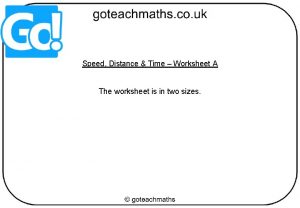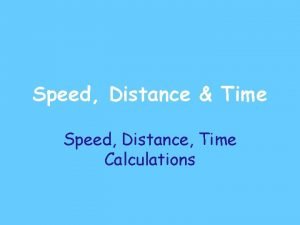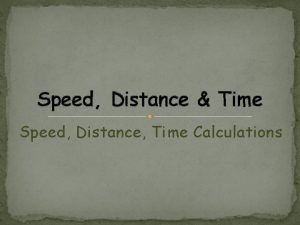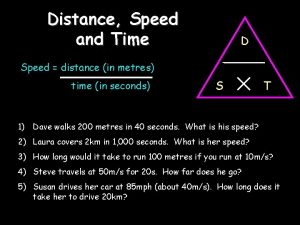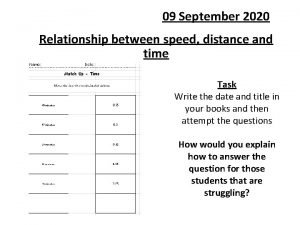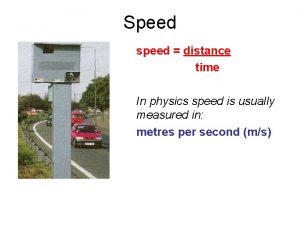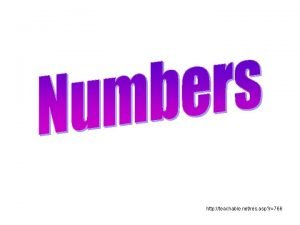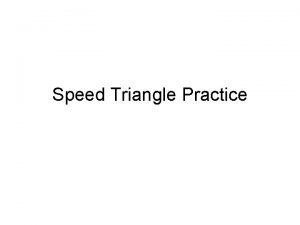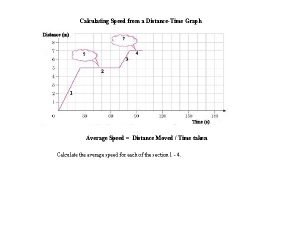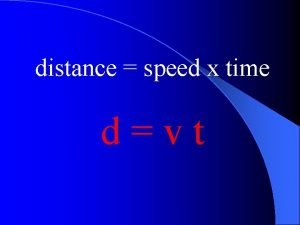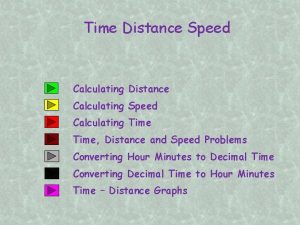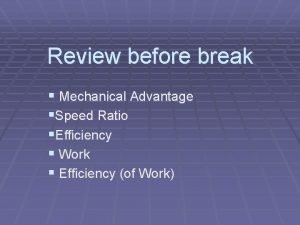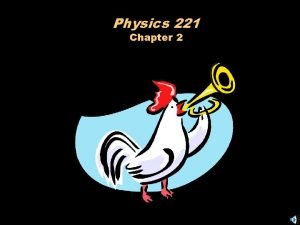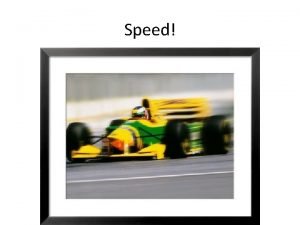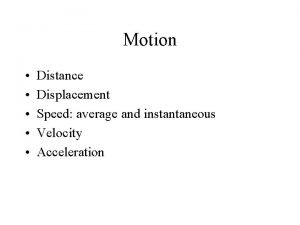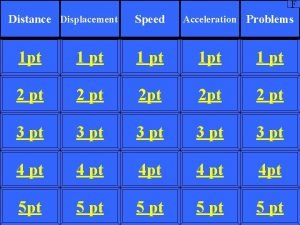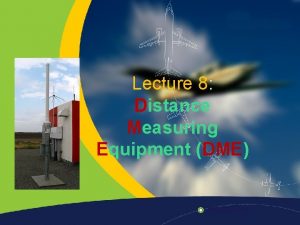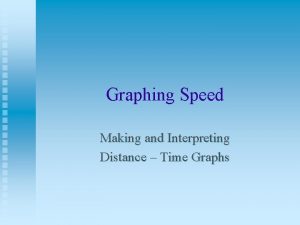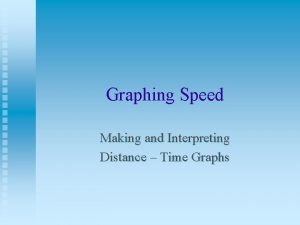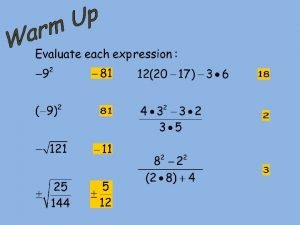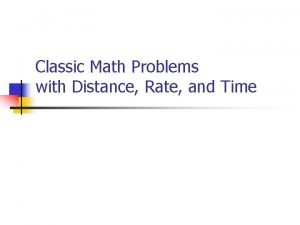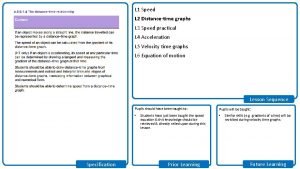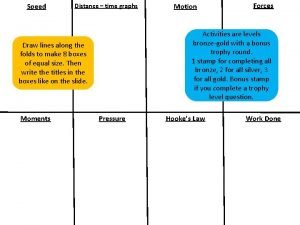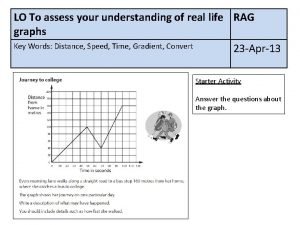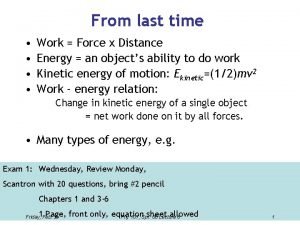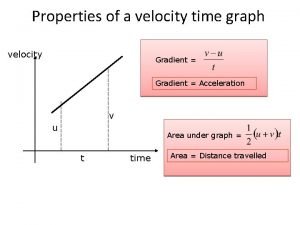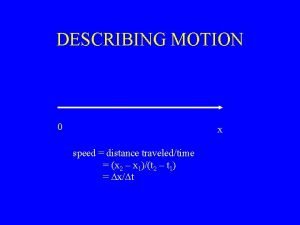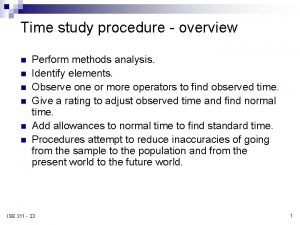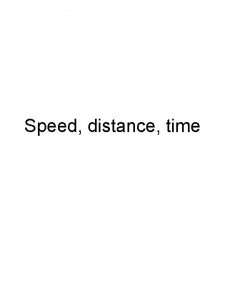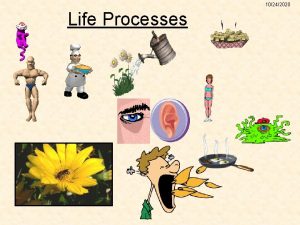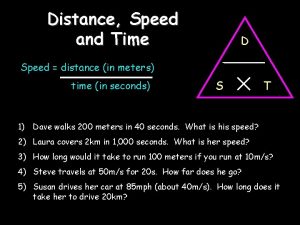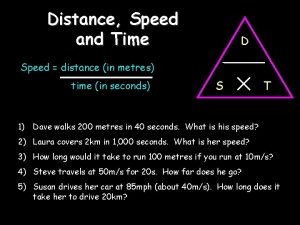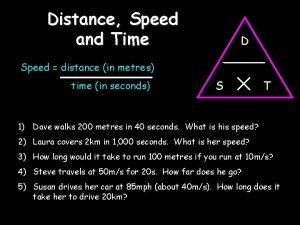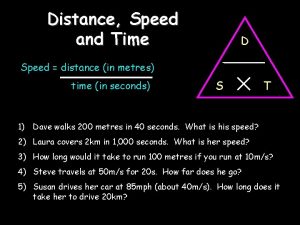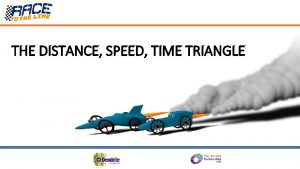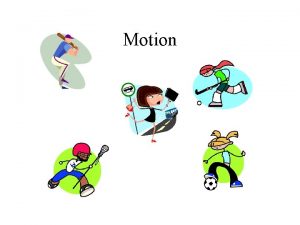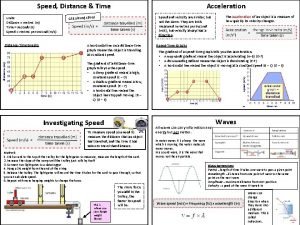10242020 Physics 2 Distance Speed and Time Speed











































































- Slides: 75

10/24/2020 Physics 2

Distance, Speed and Time Speed = distance (in metres) 10/24/2020 D time (in seconds) 1) Seb walks 200 metres in 40 seconds. What is his speed? S T 50 m/s 2) Lucy covers 2 km in 1, 000 seconds. What is her speed? 2 km = 2000 m 2 m/s 3) How long would it take Freddie to run 100 metres if he runs at 10 m/s? 10 m/s 4) Sue travels at 50 m/s for 20 s. How far does he go? 1000 m 5) Hannah drives her car at 85 mph (about 40 m/s). How long does it take her to drive 20 km? 500 s

Distance-time graphs 10/24/2020 4) Diagonal line downwards = Steady speed in other direction 2) Horizontal line = 40 Stationary 30 Distance (metres) 20 10 0 Time/s 20 1) Diagonal line = Steady speed 40 60 80 100 3) Steeper diagonal line = Faster steady speed

10/24/2020 40 Distance (metres) 30 20 10 0 Time/s 20 40 60 80 1) What is the speed during the first 20 seconds? 100 0. 5 m/s 2) How far is the object from the start after 60 seconds? 40 m 3) What is the speed during the last 40 seconds? 4) When was the object travelling the fastest? 1 m/s 40 – 60 s

Speed vs. Velocity 10/24/2020 Speed is simply how fast you are travelling… This car is travelling at a speed of 20 m/s Velocity is “speed in a given direction”… This car is travelling at a velocity of 20 m/s east

10/24/2020 Acceleration V-U Acceleration = change in velocity (in m/s) (in m/s 2) time taken (in s) A T 1) A cyclist accelerates from 0 to 10 m/s in 5 seconds. What is her acceleration? 2 m/s 2 2) A ball is dropped and accelerates downwards at a rate of 10 m/s 2 for 12 seconds. How much will the ball’s velocity increase by? 120 m/s 3) A car accelerates from 10 to 20 m/s with an acceleration of 2 m/s 2. How long did this take? 5 s 4) A rocket accelerates from 1, 000 m/s to 5, 000 m/s in 2 2000 m/s 2 seconds. What is its acceleration?

10/24/2020 Velocity-time graphs 1) Upwards line = acceleration 80 Velocity m/s 4) Downward line = deceleration 60 40 20 0 10 2) Horizontal line = Steady speed 20 30 40 50 3) Upwards line = slower acceleration T/s

10/24/2020 80 60 Velocity m/s 40 20 0 T/s 10 20 30 40 1) How fast was the object going after 10 seconds? 2) What is the acceleration from 20 to 30 seconds? 3) What was the deceleration from 30 to 50 s? 4) How far did the object travel altogether? 50 40 m/s 10 m/s 2 1 m/s 2 6700 m

10/24/2020 Balanced and unbalanced forces Consider a camel standing on a road. What forces are acting on it? Reaction These two forces would be equal – we say that they are BALANCED. The camel doesn’t move anywhere. Weight

10/24/2020 Balanced and unbalanced forces Reaction What would happen if we took the road away? Weight

10/24/2020 Balanced and unbalanced forces What would happen if we took the road away? The camel’s weight is no longer balanced by anything, so the camel falls downwards… Weight

10/24/2020 Balanced and unbalanced forces What would happen if we took the road away? The camel’s weight is no longer balanced by anything, so the camel falls downwards…

Air Resistance 10/24/2020 Air resistance is a force that opposes motion through air. The quicker you travel, the bigger the air resistance: The same applies to a body falling through a liquid (called “drag” or “upthrust”).

Balanced and unbalanced forces 10/24/2020 Forward movement Acceleration Constant speed or stopped Backwards movement

10/24/2020 Balanced and unbalanced forces 1) This animal is either stopped or moving ____ speed with steady _____… 3) This animal is getting slower _______…. 2) This animal is getting faster _____… 4) This animal is… dead

Resultant Force 10/24/2020 Calculate the resultant force of the following: 500 N 100 N to the right 400 N to the right 200 N up 700 N 200 N 700 N 600 N 50 N up 800 N 100 N

Force and acceleration 10/24/2020 If the forces acting on an object are unbalanced then the object will accelerate, like these wrestlers: Force (in N) = Mass (in kg) x Acceleration (in m/s 2) F M A

10/24/2020 Force, mass and acceleration 1) A force of 1000 N is applied to push a mass of 500 kg. How quickly does it accelerate? 2 m/s 2 F 2) A force of 3000 N acts on a car to make it accelerate by 1. 5 m/s 2. How 2000 kg heavy is the car? 3) A car accelerates at a rate of 5 m/s 2. If it weighs 500 kg how much driving force is the engine applying? 2500 N 4) A force of 10 N is applied by a boy while lifting a 20 kg mass. How 0. 5 m/s 2 much does it accelerate by? M A

Terminal Velocity Consider a skydiver: 1) At the start of his jump the air resistance is _______ small so he accelerates downwards. _______ 2) As his speed increases his air resistance will increase _______ 3) Eventually the air resistance will be big enough to _______ balance the skydiver’s weight. At this point the forces are balanced so his constant - this is speed becomes ____ called TERMINAL VELOCITY Words – increase, small, constant, balance, accelerates 10/24/2020

Terminal Velocity Consider a skydiver: 4) When he opens his parachute the air resistance suddenlyincreases ____, causing him to start _____ slowing____. down 5) Because he is slowing down his air resistance will decrease _______ again weight until it balances his _____. The skydiver has now reached a terminal velocity new, lower _______. Words – slowing down, decrease, increases, terminal velocity, weight 10/24/2020

10/24/2020 Velocity-time graph for terminal velocity… Parachute opens – diver slows down Velocity Speed increases… Terminal velocity reached… On oon M he t Time New, lower terminal velocity reached Diver hits the ground

10/24/2020 Weight vs. Mass Earth’s Gravitational Field Strength is 10 N/kg. In other words, a 1 kg mass is pulled downwards by a force of 10 N. W Weight = Mass x Gravitational Field Strength (in N) (in kg) (in N/kg) M 1) What is the weight on Earth of a book with mass 2 kg? 2) What is the weight on Earth of an apple with mass 100 g? 3) Dave weighs 700 N. What is his mass? 70 kg g 20 N 1 N 4) On the moon the gravitational field strength is 1. 6 N/kg. What will Dave weigh if he stands on the moon? 112 N

Stopping a car… Tiredness Too many drugs Thinking distance (reaction time) Too much alcohol Poor visibility Wet roads Icy roads Tyres/brakes worn out 10/24/2020 Braking distance Driving too fast

10/24/2020 Work done When any object is moved around work will need to be done on it to get it to move (obviously). We can work out the amount of work done in moving an object using the formula: Work done = Force x distance moved in J in N W in m F D

Example questions 10/24/2020 1. Bori pushes a book 5 m along the table with a force of 5 N. He gets tired and decides to call it a day. How much work did he do? 25 J 2. Alicia lifts a laptop 2 m into the air with a force of 10 N. How much work does she do? 20 J 3. Martin does 200 J of work by pushing a wheelbarrow with a force of 50 N. How far did he push it? 4 m 4. Chris cuddles his cat and lifts it 3 m in the air. If he did 75 J of work how much force did he use? 25 N 5. Carl drives his car 1000 m. If the engine was producing a driving force of 2000 N how much work did the car do? 200000 J

Elastic Potential Energy Elastic potential energy is the energy stored in a system when work is done to change its shape, e. g: a spring, a bungee cord 10/24/2020

Kinetic energy 10/24/2020 Any object that moves will have kinetic energy. The amount of kinetic energy an object has can be found using the formula: Kinetic energy = ½ x mass x velocity squared in J in kg KE = ½ in m/s mv 2

Example questions 10/24/2020 1) Nicole drives her car at a speed of 30 m/s. If the combined mass of her and the car is 1000 kg what is her kinetic energy? 450000 J 2) Shanie rides her bike at a speed of 10 m/s. If the combined mass of Shanie and her bike is 80 kg what is her kinetic energy? 4000 J

10/24/2020 Momentum Any object that has both mass and velocity has MOMENTUM. Momentum (symbol “p”) is simply given by the formula: P Momentum = Mass x Velocity (in kg m/s) (in kg) (in m/s) M V What is the momentum of the following? 1) A 1 kg football travelling at 10 m/s 0. 1 kg m/s 2) A 1000 kg Ford Capri travelling at 30 m/s 33. 3 m/s 3) A 20 g pen being thrown across the room at 5 m/s 4) A 70 kg bungi-jumper falling at 40 m/s 0. 1 m/s 2800 m/s

10/24/2020 Conservation of Momentum In any collision or explosion momentum is conserved (provided that there are no external forces have an effect). Example question: Two cars are racing around the M 25. Car A collides with the back of car B and the cars stick together. What speed do they move at after the collision? Speed = 50 m/s Mass = 1000 kg Speed = 20 m/s Mass = 800 kg Mass = 1800 kg Speed = ? ? m/s Momentum before = momentum after… …so 1000 x 50 + 800 x 20 = 1800 x V… …V = 36. 7 m/s

10/24/2020 Momentum in different directions What happens if the bodies are moving in opposite directions? Speed = 50 m/s Mass = 1000 kg Speed = 20 m/s Mass = 800 kg Momentum is a VECTOR quantity, so the momentum of the second car is negative… Total momentum = 1000 x 50 – 800 x 20 = 34000 kg m/s Speed after collision = 34000 kg m/s / 1800 = 18. 9 m/s

Random questions… 10/24/2020 1) Sophie tries to run 100 m in 12 seconds and succeeds. How fast did she run? 8. 3 m/s 2) Tommy accelerates at a rate of 2 m/s 2 for 3 seconds. If he started at 10 m/s what was his final speed? 16 m/s 3) Charlie decides to lift his book up into the air. His book has a mass of 100 g and he lifts it 50 cm. Calculate the work done. 1 g = 0. 01 N 0. 5 J 4) Lewis accelerates from 0 to 10 m/s in 5 seconds. If his mass is 70 kg how much force did his legs apply? 140 N 5) Rachel rides 1 km at a speed of 20 m/s. How long did the journey take? 50 s 6) Claire thinks it’s funny to push James with a force of 120 N. If James has a mass of 60 kg calculate his acceleration. 2 m/s 2 7) Lauren brakes do 20, 000 J of work. If the combined mass is 100 kg what speed was she travelling at? 8) Tom has a mass of 75 kg. If he accelerates from 10 to 20 m/s in 2 s how much force did he apply? 375 N

10/24/2020 9) Georgina amuses herself by throwing things at Sarah. If she throws a ball with a speed of 20 m/s and the distance between her and Sarah is 5 m how long will it take to reach her? 0. 25 s 10) Mr Richards throws calculators around the room with a force of 20 N. If each calculator has a mass of 200 g calculate the acceleration. 100 m/s 2 11) Sam has a mass of 70 kg. What is his weight on Earth, where the gravitational field strength is 10 N/kg? 700 N 12) Zak pushes a box around with a force of 1 N. He does 5 J of work and decides to call it a day. How far did he push it? 5 m 13) On the moon Matt might weigh 112 N. If the gravitational field strength on the moon is 1. 6 N/kg what is his mass? What will he weigh on Earth? 70 kg 700 N 14) Dan likes bird watching. He sees a bird fly 100 m in 20 s. How fast was it flying? 5 m/s 15) How much kinetic energy would Richard have if he travelled at a speed of 5 m/s and has a mass of 70 kg? 875 J

10/24/2020 Static Electricity Static electricity is when charge “builds up” on an object and then stays “static”. How the charge builds up depends on what materials are used: - + - + - +

10/24/2020 Static Electricity + + - - - - -

Van de Graaf generators 10/24/2020

10/24/2020 Uses of Static – Smoke Precipitators Chimney Negatively charged plates Positively charged grid - - - + + +

Circuit Symbols 10/24/2020 Variable resistor Diode Switch Bulb A V Ammeter Voltmeter LDR Resistor Cell Fuse Thermistor Battery

Electric Current Electric current is a flow of negatively charged particles (i. e. electrons). + - e- Note that electrons go from negative to positive By definition, current is “the rate of flow of charge” e- 10/24/2020

Basic ideas… 10/24/2020 Electric current is when electrons start to flow around a ammeter to measure it and it is circuit. We use an _____ measured in ____. amps Potential difference (also called _______) voltage is how big the push on the electrons is. We use a voltmeter to measure it and it is measured in ______, volts a unit named after Volta. Resistance is anything that resists an electric current. It is volts measured in _____. Words: volts, amps, ohms, voltage, ammeter, voltmeter

More basic ideas… If a battery is added the current increase will ____ because there is a push on greater _____ the electrons If a bulb is added the current will decrease _______ because there is greater resistance in the ____ circuit 10/24/2020

Current in a series circuit If the current here is 2 amps… The current here will be… 2 A 10/24/2020 The current here will 2 A be… And the current here will be… 2 A In other words, the current in a series circuit is THE SAME at any point

10/24/2020 Current in a parallel circuit A PARALLEL circuit is one where the current has a “choice of routes” Here comes the current… Half of the current will go down here (assuming the bulbs are the same)… And the rest will go down here…

10/24/2020 Current in a parallel circuit If the current here is 6 amps And the current here will be… 6 A The current here will be… 2 A

Some example questions… 3 A 6 A 1 A 1 A 1 A 3 A 1. 5 A 10/24/2020

Voltage in a series circuit If the voltage across the battery is 6 V… 10/24/2020 V …and these bulbs are all identical… …what will the voltage across each bulb be? V V 2 V

Voltage in a series circuit If the voltage across the battery is 6 V… …what will the voltage across two bulbs be? 10/24/2020 V V 4 V

10/24/2020 Voltage in a parallel circuit If the voltage across the batteries is 4 V… What is the voltage here? 4 V V And here? V 4 V

Summary 10/24/2020 In a SERIES circuit: Current is THE SAME at any point Voltage SPLITS UP over each component In a PARALLEL circuit: Current SPLITS UP down each “strand” Voltage is THE SAME across each”strand”

An example question: 6 V 3 A A 1 V 1 6 V A 3 1. 5 A A 2 V 2 3 V V 3 3 V 10/24/2020 £A

10/24/2020 Resistance is anything that will RESIST a current. It is measured in Ohms, a unit named after me. Georg Simon Ohm 1789 -1854 The resistance of a component can be calculated using Ohm’s Law: Resistance (in ) = V Voltage (in V) Current (in A) I R

An example question: 10/24/2020 Ammeter reads 2 A A V Voltmeter reads 10 V 1) What is the resistance across this bulb? 5Ω 2) Assuming all the bulbs are the same what is the total resistance in this circuit? 15Ω

10/24/2020 More examples… 3 A 6 V 12 V 4Ω 2Ω 3 A 2 A 4 V 2Ω 2 V 1 A What is the resistance of these bulbs?

Resistance 10/24/2020 Resistance is anything that opposes an electric current. Resistance (Ohms, ) = Potential Difference (volts, V) Current (amps, A) What is the resistance of the following: 1) A bulb with a voltage of 3 V and a current of 1 A. 3Ω 2) A resistor with a voltage of 12 V and a current of 3 A 4Ω 3) A diode with a voltage of 240 V and a current of 40 A 6Ω 4) A thermistor with a current of 0. 5 A and a voltage of 10 V 20Ω

10/24/2020 Resistors, bulbs and diodes

Current-voltage graphs I 10/24/2020 I I V V V 1. Resistor Current increases in proportion to voltage 2. Bulb As voltage increases the bulb gets hotter and resistance increases 3. Diode A diode only lets current go in one direction – it has very high resistance in the other direction

LDRs and Thermistors 10/24/2020

Two simple components: 1) Light dependant resistor – resistance DECREASES when light intensity INCREASES Resistance 10/24/2020 2) Thermistor – resistance DECREASES when temperature INCREASES Resistance Amount of light Temperature

Wiring a plug 1. Earth wire 10/24/2020 4. Live wire 5. Fuse 2. Neutral wire 3. Insulation The neutral wire of a plug stays at a potential close to zero relative to the Earth 6. Cable grip The live wire of a plug alternates between positive and negative potential relative to the Earth

DC and AC 10/24/2020 V DC stands for “Direct Current” – the current only flows in one direction: Time 1/50 th s AC stands for “Alternating Current” – the current changes direction 50 times every second (frequency = 50 Hz) 230 V T V

Fuses 10/24/2020 safety devices. If Fuses are _______ there is a fault in an appliance which causes the ____ live and neutral (or earth) wire to cross then a large current will flow through ______ fuse and cause it to _____. melt the _____ circuit and This will break the _______ protect the appliance and user harm from further _____. Words – large, harm, safety, melt, live, circuit, fuse

10/24/2020 Power and fuses Power is “the rate of doing work”. The amount of power being used in an electrical circuit is given by: Power = voltage x current in W in V in A P V I Using this equation we can work out the fuse rating for any appliance. For example, a 3000 W fire plugged into a 240 V 12. 5 13 supply would need a current of _______ A, so a _______ amp fuse would be used (fuse values are usually 3, 5 or 13 A).

Power and fuses 10/24/2020 Copy and complete the following table: Appliance Power rating (W) Voltage (V) Current needed (A) Fuse needed (3, 5 or 13 A) Toaster 960 240 4 5 Fire 2000 240 8. 3 13 Hairdryer 300 240 1. 25 3 Hoover 1000 240 4. 2 5 Computer 100 240 Stereo 80 240 0. 42 3 0. 33 3

Energy and Power 10/24/2020 The POWER RATING of an appliance is simply how much energy it uses every second. In other words, 1 Watt = 1 Joule per second E E = Energy (in joules) P = Power (in watts) T = Time (in seconds) P T

Earth wires 10/24/2020 metal Earth wires are always used if an appliance has a _____ fault in the appliance, causing the live case. If there is a _____ touch the case, the current “_______” surges wire to ______ down the earth wire and the ______ fuse blows. Words – fuse, fault, metal, surges, touch

Structure of the atom A hundred years ago people thought that the atom looked like a “plum pudding” – a sphere of positive charge with negatively charged electrons spread through it… Ernest Rutherford, British scientist: I did an experiment (with my colleagues Geiger and Marsden) that proved this idea was wrong. I called it the “Scattering Experiment” 10/24/2020

10/24/2020 The Rutherford Scattering Experiment Alpha particles (positive charge, part of helium atom) Most particles passed through, 1/8000 were deflected by more than 900 Conclusion – atom is made up of a small, positively charged nucleus surrounded by electrons orbiting in a “cloud”. Thin gold foil

10/24/2020 The structure of the atom ELECTRON – negative, mass nearly nothing NEUTRON – neutral, same mass as proton (“ 1”) PROTON – positive, same mass as neutron (“ 1”)

10/24/2020 The structure of the atom Particle Proton Neutron Electron Relative Mass 1 1 0 Relative Charge +1 0 -1 MASS NUMBER = number of protons + number of neutrons SYMBOL PROTON NUMBER = number of protons (obviously)

Isotopes 10/24/2020 An isotope is an atom with a different number of neutrons: Notice that the mass number is different. How many neutrons does each isotope have? Each isotope has 8 protons – if it didn’t then it just wouldn’t be oxygen any more. A “radioisotope” is simply an isotope that is radioactive – e. g. carbon 14, which is used in carbon dating.

Background Radiation 10/24/2020 13% are man-made Radon gas Food Cosmic rays Gamma rays Medical Nuclear power

Types of radiation Unstable nucleus New nucleus Alpha particle 10/24/2020 1) Alpha ( ) – an atom decays into a new atom and emits an alpha particle (2 neutrons – the nucleus protons and 2 _____ helium atom) of a ______ 2) Beta ( ) – an atom decays into a new atom by changing a neutron into a proton and electron. The fast moving, _______ Beta high energy electron is called a beta particle. Unstable nucleus New nucleus 3) Gamma – after or decay surplus ______ energy is sometimes emitted. This is called gamma radiation and has a very frequency with short high ______ wavelength. The atom is not changed. Gamma radiation Words – frequency, proton, energy, neutrons, helium, beta

Nuclear fission 10/24/2020 More neutrons Neutron Uranium or plutonium nucleus Unstable nucleus New nuclei (e. g. barium and krypton)

Chain reactions Each fission reaction releases neutrons that are used in further reactions. 10/24/2020

Nuclear Fusion in stars Proton Neutron 10/24/2020
 Comparing distance/time graphs to speed/time graphs
Comparing distance/time graphs to speed/time graphs Time distance/speed formula
Time distance/speed formula Speed distance and time
Speed distance and time Speed distance and time triangle
Speed distance and time triangle Speed distance time worksheet
Speed distance time worksheet How to compute speed
How to compute speed Speed distance time equation
Speed distance time equation Distance time speed triangle
Distance time speed triangle Distance is speed over time
Distance is speed over time Speed and time relationship
Speed and time relationship Constant speed
Constant speed Distances
Distances Formula of distance speed and time
Formula of distance speed and time Formula for speed distance and time
Formula for speed distance and time Distance = speed x time
Distance = speed x time Increasing speed distance time graph
Increasing speed distance time graph In the air triangle of velocities drift is
In the air triangle of velocities drift is Distance speed triangle
Distance speed triangle What is the distance covered per unit of time
What is the distance covered per unit of time Gcse speed distance time questions
Gcse speed distance time questions How to calculate average speed from a velocity time graph
How to calculate average speed from a velocity time graph Speedteach
Speedteach D=vt
D=vt Dr frost speed distance time
Dr frost speed distance time Calculating speed
Calculating speed Distance vs displacement
Distance vs displacement What is elapsed time
What is elapsed time The ratio of input distance to output distance
The ratio of input distance to output distance Distance formula in physics
Distance formula in physics Distance physics
Distance physics How to calculate average speed
How to calculate average speed Speed equals distance
Speed equals distance Speed velocity acceleration
Speed velocity acceleration Speed is the ratio of the distance an object moves to *
Speed is the ratio of the distance an object moves to * How dme works
How dme works Distance and time graph
Distance and time graph Distance rate time triangle
Distance rate time triangle Interpreting distance time graphs
Interpreting distance time graphs Interpreting distance time graphs
Interpreting distance time graphs Modern physics vs classical physics
Modern physics vs classical physics University physics with modern physics fifteenth edition
University physics with modern physics fifteenth edition Ib physics doc
Ib physics doc Emotions influence driving because they
Emotions influence driving because they Speed detection of moving vehicle
Speed detection of moving vehicle Fitness components
Fitness components Time distance shielding
Time distance shielding Distance rate time formula
Distance rate time formula Interpreting distance time graphs
Interpreting distance time graphs Time distance graph
Time distance graph Distance decay vs time space compression
Distance decay vs time space compression Distance divided by time
Distance divided by time Distance rate time problems
Distance rate time problems Distance-time graph story match
Distance-time graph story match Diffusion
Diffusion Speed, velocity and acceleration quiz
Speed, velocity and acceleration quiz Distance-time graph worksheet doc
Distance-time graph worksheet doc Bid rent theory
Bid rent theory Distance time graph
Distance time graph Distance time graph activity
Distance time graph activity Work is change in energy
Work is change in energy Movement and position physics igcse
Movement and position physics igcse Distance time graph
Distance time graph Non linear distance time graphs
Non linear distance time graphs Speed times time
Speed times time Gradient of vt graph
Gradient of vt graph Stationary velocity time graph
Stationary velocity time graph Speed unit
Speed unit Time x speed
Time x speed Setup time and hold time in digital electronics
Setup time and hold time in digital electronics Simple interest business math
Simple interest business math Calculating iv infusion rate
Calculating iv infusion rate Seek time hard disk
Seek time hard disk Work study techniques
Work study techniques How to perform a time study
How to perform a time study Takt time vs cycle time
Takt time vs cycle time Lead time bias vs length time bias
Lead time bias vs length time bias




